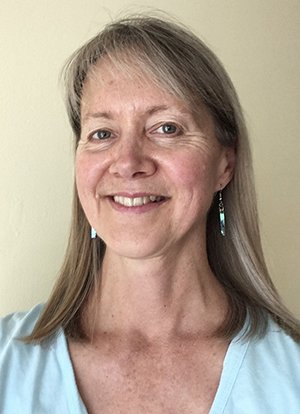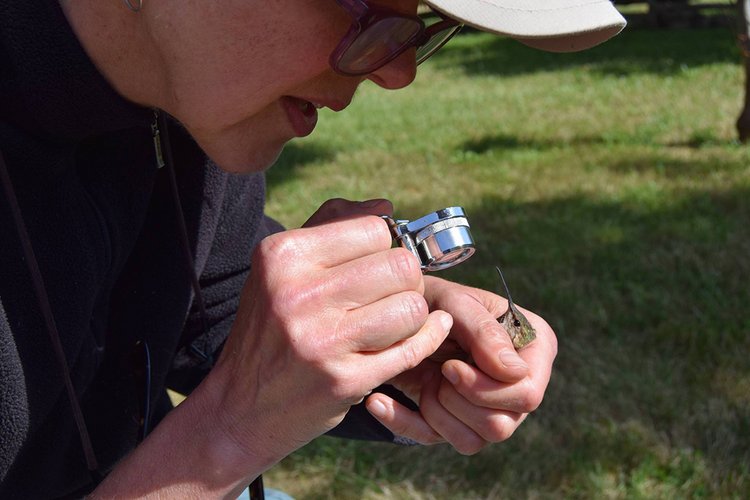Biologist Sara Hiebert Burch '79 Honored for Excellence and Innovation in Science Education

Sara Hiebert Burch '79, the Edward Hicks Magill Professor Emerita of Mathematics and Natural Science, spent a career refining her teaching practices, always aiming to grow along with her students.
Recently awarded the M. Patricia Morse Award for Excellence and Innovation in Science Education, she reflected on the ways her teaching evolved at Swarthmore and the pride at her students’ continued accomplishments. “This award means so much to me because the nomination was initiated by former students who have themselves become excellent, innovative teachers in their own right,” says Hiebert Burch, whose work and research focused on animal physiology, specifically torpor, a kind of shallow, short-term hibernation, in hummingbirds and small mammals.
The award, which recognizes the ways in which educators foster innovation in the classroom, is given annually by the Society for Integrative and Comparative Biology. Hiebert Burch learned the news through a surprise Zoom call. Though anticipating a conversation with friends, she instead saw on the screen “not the advertised friends, but the two former students who had nominated me, to tell me that I had received the award,” she says. “It was a very happy surprise.”
Hiebert Burch learned the value and power of original research projects as a graduate student, when she served as a teaching assistant in physiology courses taught by Ingrith Deyrup-Olsen at the University of Washington.
Deyrup-Olsen “was also the person who first introduced me to Trish Morse, in whose honor the award is given each year, and both of them were important mentors to me as I started my own teaching career,” says Hiebert Burch, who retained the project-based laboratory model when she started teaching her own classes “so that students in my courses could also experience actually doing science.”
A “firm requirement” in Hiebert Burch’s courses was that a study could not repeat something that had already been done. “It needed to be truly original research,” she says. “Each of these student projects posed a different set of challenges because no two projects were exactly alike.”
After her first semester of teaching Animal Physiology, one of her colleagues commented on how much work the independent projects must have been and suggested she wouldn’t repeat the process. But Hiebert Burch thought differently about it. “For students, there is nothing as exciting as doing a study that no one has done before and discovering something new, and for me, there was nothing as exciting as facilitating this experience for students,” says Hiebert Burch. “That’s what convinced me it was worth continuing this way of teaching.”
When Hannah Watkins ’21 found herself in Hiebert Burch’s class her sophomore year, she was fresh out of BIO 002 and feeling out of her depth. “The class was enormously challenging, but although much of it was out of my reach to start with, Sara knew how to give me the tools I needed to work through it myself,” says Watkins, a biology major and environmental studies minor from Anchorage, Alaska. “Sara was always finding ways to show me that my areas of expertise — all of which were miles away from physiology — had overlapping skill sets that I could apply to the work in front of me.”
The first inspiration for changing teaching methods came from physics education literature in the 1990s, says Hiebert Burch. She wondered: How could her own students learn more and in more collaborative ways?
“I began incorporating ‘interactive engagement’ activities for my lecture classes and eventually moved to a partially ‘flipped’ classroom so that we could spend more time cementing concepts by using them to solve problems, rather than simply talking about them,” she says. She swapped strategies — so some information that would have been in a lecture was instead presented in videos that students watched before class. “This freed up time for interactive work when we were all together in the classroom,” she says.
Hiebert Burch quickly observed a change in the classroom. “Suddenly, students had many more questions than when the information was presented in a traditional lecture,” she says. “It was as if they had acquired entirely new criteria for what it meant to understand something.”
The clicker technique, promoted by Harvard physicist Eric Mazur, led the way for Hiebert Burch. Her first “clickers” were packs of lettered response cards. “Instead of clicking to indicate their answer to a problem, each student would hold up the card indicating their response,” she says. “I’ll never forget the day I first used the cards in my class — as with many of these new practices, the result was nothing short of spine-tingling.”

Hiebert Burch’s work and research focuses on animal physiology, specifically torpor, a kind of shallow, short-term hibernation, in hummingbirds and small mammals.
In the past when she had asked the class a question, only a few students might respond. “Now, I could see everyone's response,” she says. “That changed everything, not least my understanding of what my teaching had and had not successfully conveyed.”
Eventually, Hiebert Burch moved to using anonymous electronic clickers, but they didn’t provide one of the most valuable pieces of information that the cards offered: how students with different answers were spatially clustered in the classroom.
That helped her to better understand what would happen next, when students would discuss their answers in small groups with classmates seated near them. Of the original analog response system, Hiebert Burch says, “Sometimes the rubber bands that held the packs of response cards together broke, but I never had to buy new batteries or reboot my clicker response software when it failed in the middle of a class.”
For Watkins, the lessons from Hiebert Burch’s classroom continue to resonate. “She was always gracious of my mistakes, a thoughtful and kind mentor in every way, and was never impatient even when I requested another explanation for the umpteenth time,” says Watkins. “While working for her, I developed an enormous sense of respect for the role of mentor, a word too small for all the many ways in which she guided, supported, and encouraged myself and my partner.
“I hope to one day give the same gift of compassion, wisdom, and patience to another person that Sara gave to me — and if I am capable of such a thing, it will surely be due in no small part to her intelligence and dedication as a professor.”


